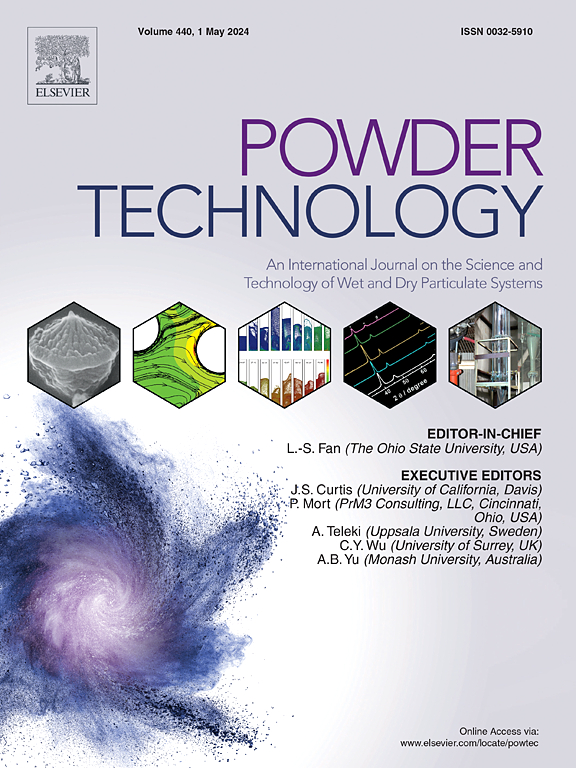Pseudo-viscous modeling of transport in dense granular flows for thermal energy storage applications
IF 4.5
2区 工程技术
Q2 ENGINEERING, CHEMICAL
引用次数: 0
Abstract
Dense, granular flows were examined to effectively capture and model bulk viscous properties in thin packed beds. A modified Couette cell with particle image velocimetry was used to experimentally determine pseudo-viscosity properties of four particulate media with varying morphologies: (1) iron oxide-coated SiO2 particles, (2) CARBOBEAD CP30-60 particles, (3) CARBOBEAD CP40-100 particles, and (4) Al2O3 beads. The pseudo-viscosity functions were fitted using a power law to correlate the measured shear stress as a function of measured shear rate. The pseudo-viscous functions were used as inputs to computation fluid dynamics models for a single-phase viscous fluid to predict granular flow profiles. Steady-state free surface velocity profiles at angular velocities <7 rad/s predicted by the model were in good agreement with the experimental particle image velocimetry measurements, resulting in Pearson correlation coefficients of 0.97 for iron-oxide coated SiO2 particles and 0.95 for CP30-60 particles. This alternative approach to measuring pseudo-viscous properties under shearing and modeling bulk transport behavior of granular flow using computation fluid dynamics model offered significant reduction in computational load compared to discrete element methods.

致密颗粒流输运的伪粘性模拟在热能储存中的应用
为了有效地捕捉和模拟薄充填层中的大块粘性特性,研究了致密颗粒流。采用改进的Couette细胞和颗粒图像测速仪,实验测定了四种不同形态的颗粒介质的伪粘度特性:(1)氧化铁包覆SiO2颗粒,(2)CARBOBEAD CP30-60颗粒,(3)CARBOBEAD CP40-100颗粒和(4)Al2O3颗粒。伪粘度函数采用幂律拟合,将实测剪切应力作为实测剪切速率的函数进行关联。将拟粘性函数作为输入,计算单相粘性流体的流体动力学模型,以预测颗粒流动剖面。模型预测的角速度<;7 rad/s下的稳态自由表面速度分布与实验颗粒图像测速测量结果吻合良好,结果表明氧化铁涂层SiO2颗粒的Pearson相关系数为0.97,CP30-60颗粒的Pearson相关系数为0.95。与离散元方法相比,这种测量剪切作用下的伪粘性特性和使用计算流体动力学模型模拟颗粒流整体输运行为的替代方法显著减少了计算负荷。
本文章由计算机程序翻译,如有差异,请以英文原文为准。
求助全文
约1分钟内获得全文
求助全文
来源期刊

Powder Technology
工程技术-工程:化工
CiteScore
9.90
自引率
15.40%
发文量
1047
审稿时长
46 days
期刊介绍:
Powder Technology is an International Journal on the Science and Technology of Wet and Dry Particulate Systems. Powder Technology publishes papers on all aspects of the formation of particles and their characterisation and on the study of systems containing particulate solids. No limitation is imposed on the size of the particles, which may range from nanometre scale, as in pigments or aerosols, to that of mined or quarried materials. The following list of topics is not intended to be comprehensive, but rather to indicate typical subjects which fall within the scope of the journal's interests:
Formation and synthesis of particles by precipitation and other methods.
Modification of particles by agglomeration, coating, comminution and attrition.
Characterisation of the size, shape, surface area, pore structure and strength of particles and agglomerates (including the origins and effects of inter particle forces).
Packing, failure, flow and permeability of assemblies of particles.
Particle-particle interactions and suspension rheology.
Handling and processing operations such as slurry flow, fluidization, pneumatic conveying.
Interactions between particles and their environment, including delivery of particulate products to the body.
Applications of particle technology in production of pharmaceuticals, chemicals, foods, pigments, structural, and functional materials and in environmental and energy related matters.
For materials-oriented contributions we are looking for articles revealing the effect of particle/powder characteristics (size, morphology and composition, in that order) on material performance or functionality and, ideally, comparison to any industrial standard.
 求助内容:
求助内容: 应助结果提醒方式:
应助结果提醒方式:


